Iceland 2018 - Trip Report
Posted by Mark Richardson on Sep 01, 2018
Rjupnavellir is a few huts in the centre of a campsite, it's an open and exposed location. There's a wardens hut which was closed when I arrived, and a note explained that the warden would be back in the evening... a few minutes later he drove up. As it was only 3.30pm I was looking to walk on a bit before camping and anyway the warden explained that the site was now shut for the winter, he added that it would probably be Ok for me to stay. I quizzed him about the opportunities for camping further upstream but he was non committal, saying there was nowhere really to camp – I realised later this conversation must have been awkward for him because wild camping is definitely frowned upon, oblivious I prised some advice out of him and set off up the path.
The weather was cloudy but dry, the terrain is dominated by Burfell on the left rising out of the plain, patches of yellow grass and grey flowers yield to hillsides of grey ash in the distance. I followed the river for an hour on a patchy track and eventually came to a bridge with a decent area of flat ground on which to pitch my tent. The warden had said that there was no water beyond this crossing so I camped for the night, I had only walked for an hour but I was pleased that I had started.

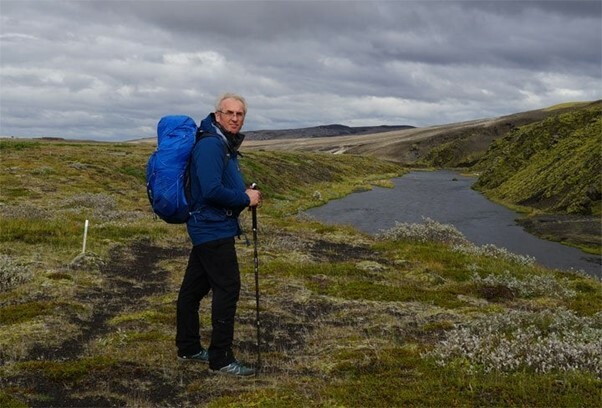
Day 2 – Afangagil to Landmannahellir
The path out from Afangagil is diagonally up an ash slope to a crest continuing down across a wide valley offering great views of Hekla in the distance. The weather was good, cloudy but dry and it would get much clearer towards the end of the day with some clear blue skies to lift the mood. The trekking is easy on generally level ground with the odd climb in or out of a valley, the scenery is distinctively grey with patches of grass on higher ground. I could visualise volcanic ash steadily filling up the valleys to create a new surface to walk on, flat, grey but having a stark beauty.
A brown patch of mud becomes a welcome relief from the greys and greens of the hills, and the red tinged crater of Valagja adding further interest. Breaking out of another valley the track winds its way across a rougher, jagged plain made up of lava in all its contorted glory, covered in green vegetation. I was glad the path was well waymarked through this natural maze. At its centre a river flows and I reached this around lunchtime, it was too deep to cross without fording, I stepped onto a 'sandbank' of ash and my foot immediately disappeared so I retreated to put on my fording footwear. It was easy to ford and I had lunch at the other side.
A few hours later I reached the lake Herbjarnarfellsvatn which is about twenty minutes before my destination and contemplated camping on a relatively flat area I could see at its edge. On closer inspection it was ok but not a great pitch, too boggy, and the wind was quite strong with nothing to provide shelter, I wandered back to the path and over a crest, as soon as I passed over the high point of the trail the wind dropped completely, I could see Landmannahellir in the distance and that there were vehicles there, I revisited the idea of camping by the lake, in the end I descended to Landmannahellir where there was an official campsite - albeit I was the only camper. The landscape and long sunset were magical.

Ash plains

Afangagil
Day 3 – LandmannaHellir to Landmannalauger
There was a price for the clear skies, the night time temperatures dropped to a degree above freezing, leaving a light frosting on the tent come morning, by 7.30 though the sun was hitting the tent warming things up considerably. After a good breakfast and a lazy packing up I left Landmannahellir at 9.00am, the weather was beautiful but I could see clouds building in the distance.
The route climbs to a saddle the drops to a lake which I reached after an hour, this would make a great place to camp, in contrast to Herbjarnarfellsvatn there was good shelter from the surrounding hills. I presume you could get away with wild camping but only at this time of the year – the campsite at Landmannahellir is big and indicates that the area will be covered with people in peak season.
The route crosses a fell to a road, beyond which it rises again to a distant crest taking in a deep gorge with some rocky outcrops. As I gained height the wind increased, as did the cloud cover, over the crest the route undulates over sparsely vegetated broad plateaus with mountains and lakes in the distance.
I cowered in a rocky niche out of the wind and had a quick lunch before heading off again. Apart from the campsite warden at Landmannahellir I hadn't seen another soul for three days and was very happy with that, I like my own company, but as the afternoon wore on I got closer to Landmannalauger and began to see a few hikers on surrounding peaks. There's a point at which you start to see the mountains around Landmannalauger which are full of colour, it quickens the pace, then you top a crest and the landscape opens up in front of you, there's a wide flood plain with multi-coloured hills sprouting out of the ground at its edges – it’s an amazing view. In the distance there’s a stretch of knarled lava that blocks the end of the valley, the route crosses the plain then traces its edge to reach the lava flow, a path has been created through the contorted rocks leading to Landmannalauger on the other side.
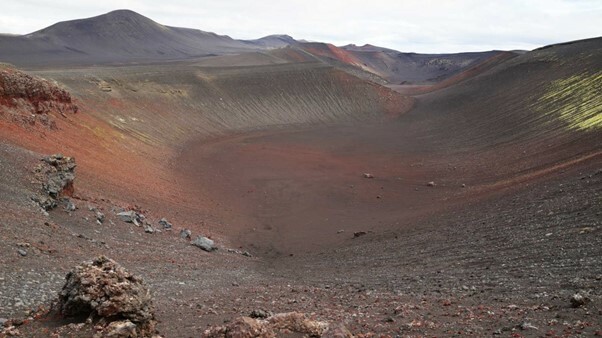
Valagja
Landmannalauger is a significant place, it's accessible by road and has a number of buildings and a campsite, there's also a 'hot river' fed from a nearby spout and the surrounding hills boast an astonishing range of colours. It's the start of Iceland's most popular trek, the Laugevegur which heads out in a south-westerly direction. I have to thank Paddy Dillon for suggesting the extended trek which I was doing because my route into the Landmannalauger area showed the best views it has to offer - hikers starting from the camp at Landmannalauger to do the Laugevegur will frankly miss one of the highlights, unless they take the time to hike north-west for an hour or so in order to capture the views which I had.
By the time I arrived it was 3pm and the weather was quite chilly, I pitched my tent and contemplated the hot river, the changing facilities were a wooden platform and a few hooks for clothes, I read the disclaimer which amounted to 'go in at your own risk' and an added warning about 'swimmers itch' – for which 'swimmers scratch' was the only remedy. Parking my English reserve I joined the dozen or so hardy souls in the water, it's not deep enough for swimming but ideal for bathing. It's very pleasant, though the river still has those other things you find in rivers, grit, weeds, dirt and other people.
Day 4 – Landmannalauger to Hvanngil
I left the campsite the following morning at 8.15, the weather was quite poor, wind and rain, as I picked my way back through the lava field onto a colourful shoulder with various holes in the ground spewing sulphurous steam. As I gained height the weather worsened, stronger wind and heavier rain with low cloud drifting across the trail reducing visibility substantially.
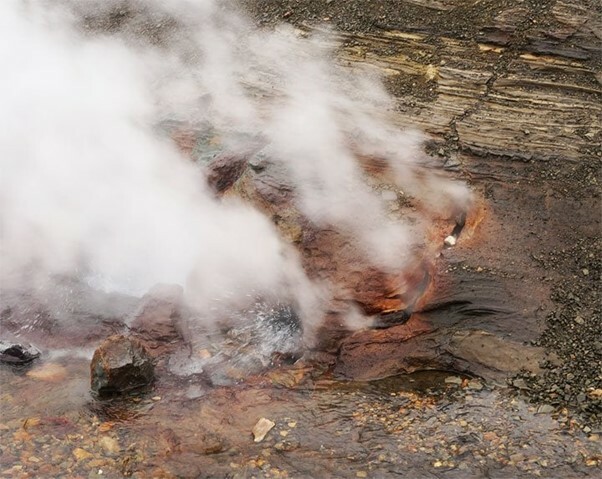
Sulphurous steam
The guidebook suggests stopping after 4-5 hours at the hut at Hrafntinnusker which I reached at ten minutes before Noon, the weather was not letting up, the wind was getting quite severe and I was looking forward to a bit of shelter. When I arrived a group of hikers were sheltering on the lee side of the hut, on the door was a notice saying 'Closed for Cleaning till 1pm' - I couldn't believe it, the only purpose of this hut was to provide shelter for hikers - and here were about twenty people in foul weather not being allowed to sit inside.
I ate my lunch standing up in the rain and wind. It didn't seem like a pleasant place to stop and the next 'day' according to the guidebook was only another 4-5 hours walk - I decided to go on. From here the trail crosses successive rounded plateaus passing brightly coloured hillsides and one decidedly orange river. The trail is well waymarked with posts about every 30 metres, today I could see why, visibility was from one post to the next. At the highest point there’s a memorial to a hiker who died in a blizzard in 2004, not far from a hut, he was just 25 years old.
I ploughed on, heading for the campsite at Alftavatn, the wind was now 'blow you over' strong and the rain was heavy, neither let up even though we eventually dropped into a valley. I was glad to see the huts of Alfavatn appear out of the mist at about 3.30pm. One was marked up as the wardens hut and I asked inside about camping, the young girl said that she didn’t think I wanted to camp here, there was no shelter from the wind and by walking on another 3.5km to Hvanngil I would reach another campsite surrounded by lava which would provide more protection.
I took the advice and continued on through the weather, the trail leads over a crest and along a valley, to my dismay it then arrives at a river which requires fording. My feet were already wet and I contemplated just ploughing through it, but wet feet are less of a problem than boots full of water so I switched to my fording footwear and got across, the Gurkha group approached the riverbank as I was putting my boots back on, two or three of them ploughed through the water.
Further on I passed a hiker with a large nylon bundle attached to his chest, inside I realised was a dog, unable to deal with the high winds the dog whimpered under the fabric as its master carried the dog, a rucksack and a set of dog panniers.
Eventually I reached Hvanngil, still gripped by the storm, there’s a hikers barn in a field and camping pitches in amongst lava debris which afforded some protection. I pitched the tent, burying the pegs and stuffed my dry gear inside, grabbing the cooking gear and some food I headed for the hikers barn, it was full of Gurkhas, plus some other hikers who were clearly going to sleep there. I climbed the stairs onto the loft platform and immediately realised that there were too many people in the cramped space, I returned to my tent and cooked in the porch.
I was damp but not in too bad shape, my waterproof jacket and pants were both wet on the inside – they had done very well but 9 hours in the wind and rain tends to overcome most waterproof systems in one way or another. A little praise for the Packtowl Ultralite; I used it continually, wringing out when it was too wet, then using it again, it got me from dripping wet to damp-ish.
After the onslaught and despite the wind I got a great nights sleep. The forecast was for the wind and rain to clear from mid-morning the following day so the plan was to sleep in till the weather improved.
Day 5 – Hvanngil to Botnar/Emstrur
The wind had died down by the morning although not completely, and it came back in the occasional fierce gusts, looking outside the tent you could hardly see anything except for a wall of water being blown the length of the valley. I went to the warden's hut and had a good chat about the forecast, it was still due to clear by lunchtime, and the next few days were good. I returned to my tent to wait it out.
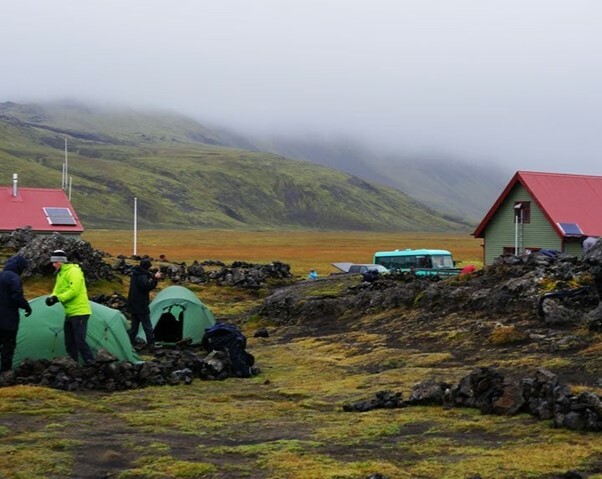
The weather did indeed improve and around 9.30 it had stopped raining, but by 10.00am it was deteriorating again and the campsite was on the move, I decided to join them rather than waiting any longer.
By the time I headed off it was raining again and it got worse for another hour before easing off then finally stopping, by which time I had reached the river Blafjallakvisl, which is wide and deep requiring fording. Once across this the trail stretches into the distance over a flat ash plain bounded by green and black mountains, in better weather you can clearly see the Myrdalsjokull glacier but I only got glimpses of it between breaks in the cloud.
Towards the end of the plain the terrain rises to a crest, this is close to the huts at Botnar which are just a short descent away. The guide recommends a detour to the Markarfljotsgljufur canyon, which is a jumble of greens reds and yellows, there was a bus trip on the other side, much too far away to attempt contact, but I hoped their view was as good as mine because the canyon is spectacular.
I arrived in Botnar at about 3pm, the weather was dry and it was a chance to get my gear dry and organised before a leisurely evening meal in the dining tent/marquee.
Day 6 - Botnar to Porsmork
The trek today was 6 hours to Porsmork, the notional end of the Laugevegur, and despite a great weather forecast it was chucking it down at about 7.00am when I was having breakfast in my tent. I eventually left during a break in the weather about an hour later, the route picks its way through ash covered hills and descends a rocky gully towards a steep sided ravine with a couple of footbridges giving easy access to the other side.
As the weather brightened the two glaciers Myrdalsjokull and Eyjafjallajokull could be seen on the relatively close horizon, tomorrows route climbs the mountains between them before descending to the coast.
At 11.30 I stopped for some lunch, my legs were feeling pretty lethargic whereas yesterday I could have gone on for miles, this was a bit of a concern which I attributed to not eating enough food. Thankfully the next section was easy walking and the views spectacular, especially as I gained height again.
Eventually the trail drops into a wide bottomed river valley where there's a large river to cross, I was looking for the widest section, which is usually the shallowest and slowest, I found what looked like faint vehicle tracks and settled on this place to ford the river.
At the other side I climbed into a forest on a track and arrived at a large sign, there are two alternate points to end the Laugevegur and as I was walking further - to Skogar - I would need to go to Langidalur. The sign explained that there was another campsite a bit further beyond Langidalur but still on my route - and it was beautiful - not my words, but it would save up to an hour on my next days route.


As I got closer to Langidalur more and more people appeared on the trail, day hikers and visitors to the area, I reached the buildings at Langidalur about 3pm, by this time the weather was hot and sunny, I sat at a picnic table with a French couple who had just arrived from Skogar and were walking the same trail in the opposite direction, I had a bit more food.
The number of people and the promise of a beautiful campsite spurred me on and I hiked the extra 45 minutes to Basar, where the campsite is definitely worth the extra effort, its nestled in low trees with private pitches marked out with bushes, I guess it wouldn’t be as good in the high season, but in its deserted state it was a lovely place to camp.
I pitched near to a picnic table and pulled out my emergency rations, a 1000 calorie beast of porridge with Strawberries, I managed to eat about 85% of it before I gave up, and as it was still afternoon I went on to have my normal full evening meal at around 7pm. This would sort my legs out the following day.
Day 7 – Basar to Skogar
Basar to Skogar is 18 miles and over ten hours according to the guide, the route climbs for half that time to the crest of the mountains between the Myrdalsjokull and Eyjafjallajokull glaciers then descends to the coast, mainly following the river canyon to Skogar. It can be done over two days and there are two huts near to the top, at the halfway point, but camping is not recommended, the guide doesn't really say why but having been up there I think it's just because it's a very barren section which seems quite grim.
I decided to see how long it took me to get to the huts and make a decision on whether to go on. The climb is the toughest on the route, initially through woods and scrub covered mountain but laterally up barren hillsides of ash. We got a cloud inversion, I could see clear peaks poking up through the white cloud and in the distance were plumes of steam and gas rising from holes in the ground.


As we reached the higher ground the terrain became darker with a rich red hue in places, there were large snow patches to negotiate and areas of sharp rocky lava scree. As it only took four hours to reach the highest point I decided to carry on, half an hour later I reached the Baldvinsskali hut and decided to have lunch. As I sat at the picnic table I read a sign saying there was a service charge at the hut of 500 Icelandic Krona (about £3.21) even if you only looked at it, affronted by this I found a rock to sit on, the Gurkhas arrived to join me.
After taking a group photo we all set off down a stony track which eventually joins the river and follows it towards the distant sea as it carves out a deep canyon. Nesting seabirds inhabit the rocky sides and swoop impressively back and forth. Waterfall after waterfall is admired and photographed by the every growing numbers of visitors, it's obvious when you near the end of the trail as there are more people in that one place than you've seen for a week. You approach the top of the Skogarfoss waterfall and watch it crash over the rocky edge, then I followed the steps down the left hand side to the throngs below, I walked up to the falls, which are truly impressive, and which mark the end of the trail - it was 4pm.

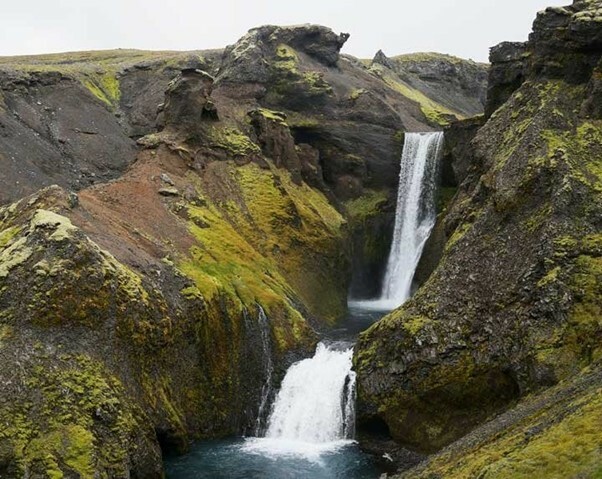
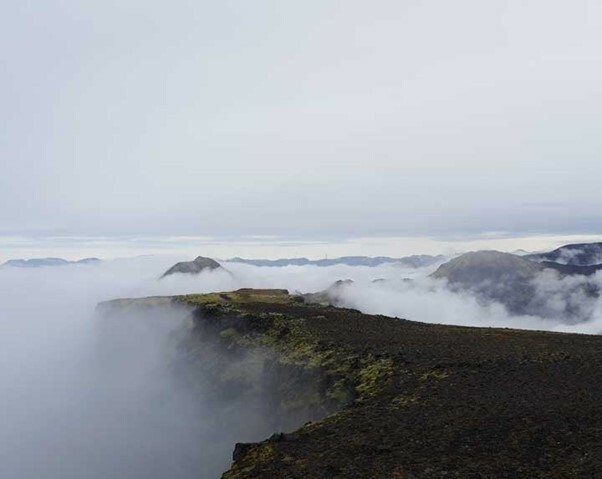

|
||
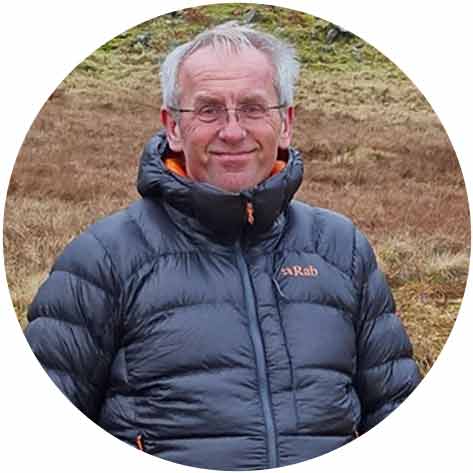 |
||
|
Mark Richardson |
||
|
Mark was the founder of Ultralight Outdoor Gear back in 2006 and has completed long distance backpacking routes in some of the remotest parts of the world. His favourite hikes have been Torres del Paine (full circuit), the John Muir trail and the Markha Valley trail (Ladakh, India). Although semi-retired Mark has not lost any enthusiasm for minimalist backpacking and is tackling Scotland’s Munros choosing multi-day backpacking routes over the more usual guide book excursions. |
||
